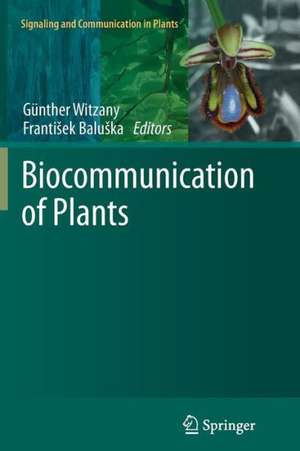Biocommunication of Plants: Signaling and Communication in Plants, cartea 14
Editat de Günther Witzany, František Baluškaen Limba Engleză Paperback – 23 feb 2014
| Toate formatele și edițiile | Preț | Express |
|---|---|---|
| Paperback (1) | 1221.07 lei 6-8 săpt. | |
| Springer Berlin, Heidelberg – 23 feb 2014 | 1221.07 lei 6-8 săpt. | |
| Hardback (1) | 1226.73 lei 6-8 săpt. | |
| Springer Berlin, Heidelberg – 22 ian 2012 | 1226.73 lei 6-8 săpt. |
Din seria Signaling and Communication in Plants
- 15%
 Preț: 641.71 lei
Preț: 641.71 lei - 24%
 Preț: 793.47 lei
Preț: 793.47 lei - 24%
 Preț: 1208.95 lei
Preț: 1208.95 lei - 18%
 Preț: 1118.13 lei
Preț: 1118.13 lei - 24%
 Preț: 783.53 lei
Preț: 783.53 lei - 18%
 Preț: 1111.53 lei
Preț: 1111.53 lei - 18%
 Preț: 998.34 lei
Preț: 998.34 lei - 18%
 Preț: 1545.57 lei
Preț: 1545.57 lei - 18%
 Preț: 1547.81 lei
Preț: 1547.81 lei - 18%
 Preț: 951.29 lei
Preț: 951.29 lei - 24%
 Preț: 796.83 lei
Preț: 796.83 lei - 18%
 Preț: 942.63 lei
Preț: 942.63 lei - 18%
 Preț: 1219.77 lei
Preț: 1219.77 lei - 18%
 Preț: 954.31 lei
Preț: 954.31 lei - 18%
 Preț: 953.20 lei
Preț: 953.20 lei - 18%
 Preț: 1388.05 lei
Preț: 1388.05 lei - 18%
 Preț: 956.50 lei
Preț: 956.50 lei - 18%
 Preț: 942.63 lei
Preț: 942.63 lei - 18%
 Preț: 943.73 lei
Preț: 943.73 lei - 24%
 Preț: 1053.39 lei
Preț: 1053.39 lei - 18%
 Preț: 941.48 lei
Preț: 941.48 lei - 18%
 Preț: 943.57 lei
Preț: 943.57 lei - 18%
 Preț: 943.43 lei
Preț: 943.43 lei - 18%
 Preț: 944.51 lei
Preț: 944.51 lei - 18%
 Preț: 945.30 lei
Preț: 945.30 lei - 18%
 Preț: 944.19 lei
Preț: 944.19 lei - 18%
 Preț: 948.92 lei
Preț: 948.92 lei
Preț: 1221.07 lei
Preț vechi: 1489.10 lei
-18% Nou
Puncte Express: 1832
Preț estimativ în valută:
233.65€ • 244.60$ • 193.33£
233.65€ • 244.60$ • 193.33£
Carte tipărită la comandă
Livrare economică 07-21 aprilie
Preluare comenzi: 021 569.72.76
Specificații
ISBN-13: 9783642448959
ISBN-10: 364244895X
Pagini: 396
Ilustrații: X, 386 p.
Dimensiuni: 155 x 235 x 21 mm
Greutate: 0.54 kg
Ediția:2012
Editura: Springer Berlin, Heidelberg
Colecția Springer
Seria Signaling and Communication in Plants
Locul publicării:Berlin, Heidelberg, Germany
ISBN-10: 364244895X
Pagini: 396
Ilustrații: X, 386 p.
Dimensiuni: 155 x 235 x 21 mm
Greutate: 0.54 kg
Ediția:2012
Editura: Springer Berlin, Heidelberg
Colecția Springer
Seria Signaling and Communication in Plants
Locul publicării:Berlin, Heidelberg, Germany
Public țintă
ResearchCuprins
Keylevels of Biocommunication in Plants.- Information and Communication in Higher Plants.- Plant Hormones and Metabolites as Universal Vocabulary in Pathogen Defense Signaling.- Gravity Sensing/Interpretation and Response Behavior.- Wound Response to Mechanical Damage.- Transport and Signaling via the Phloem.- Intercellular Communication During Floral Development.- Cell Wall Signaling.- Plant Root Signaling Between Same, Related and Non-related Plant Roots.- PCD and Plant Life Cycle.- Herbivore- and Pathogen-derived Signals that Induce or Suppress direct and Indirect Defenses in Plants.- Nematode-Plant Communication and Rhizobial-Plant Communication.- Plant Virus Operations Control Centers.- Plant-Microbe Interactions.- Recent Trends on the Olfactory Responses of Insect Natural Enemies to Plant Volatiles.- Plant Defense Against Insect Herbivore Attack.- Volatiles Mediating Information Between Bacteria and Plants.- Infection of Plants by the Human Pathogen Salmonella typhimurium.- Co-adaptationary Aspects of the Underground Communication Between Plants and Other Organisms.- Mutual Communication of Plants, Animals, Fungi and Bacteria.
Textul de pe ultima copertă
Plants are sessile, highly sensitive organisms that actively compete for environmental resources both above and below the ground. They assess their surroundings, estimate how much energy they need for particular goals, and then realise the optimum variant. They take measures to control certain environmental resources. They perceive themselves and can distinguish between ‘self’ and ‘non-self’. They process and evaluate information and then modify their behaviour accordingly. These highly diverse competences are made possible by parallel sign(alling)-mediated communication processes within the plant body (intraorganismic), between the same, related and different species (interorganismic), and between plants and non-plant organisms (transorganismic). Intraorganismic communication involves sign-mediated interactions within cells (intracellular) and between cells (intercellular). This is crucial in coordinating growth and development, shape and dynamics. Such communication must function both on the local level and between widely separated plant parts. This allows plants to coordinate appropriate response behaviours in a differentiated manner, depending on their current developmental status and physiological influences. Lastly, this volume documents how plant ecosphere inhabitants communicate with each other to coordinate their behavioural patterns, as well as the role of viruses in these highly dynamic interactional networks.
Caracteristici
This volume documents how plant ecosphere inhabitants communicate with each other to coordinate their behavioral patterns and shows the role of viruses in this highly dynamic interactional networks State-of-the-art contentstate-of-the-art contents Gives a modern approach Includes supplementary material: sn.pub/extras











